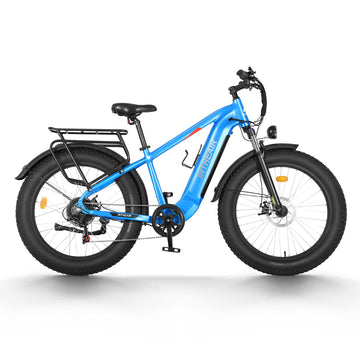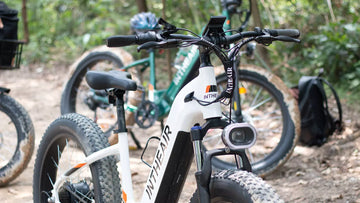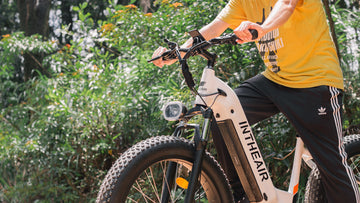Daily Care and Maintenance
Cleaning and Storage
If you see stains on the bike body, wipe them off with a damp cloth. If the stains won't scrub off, put on some toothpaste, and brush them with a tooth brush, then wipe them off with a damp cloth.Notes: do not clean the bike with alcohol, gasoline, kerosene or other corrosive and volatile chemical solvents to prevent dire damage. Do not wash the bike with a high-pressure water spray. During cleaning, make sure that the bike turned off, the charging cable is unplugged, and the rubber flap is closed as water leakage may result in electric shock or other major problems. When the bike not in use, keep it indoors where it is dry and cool. Do not put it outdoors for along time. Excessive sunlight, overheating and over cooling accelerate the battery pack's life span.
Battery Maintenance
- Useoriginal battery packs, use of other models or brands may bring about safety issues;
- Donot touch the Do not dismantle or puncture the casing. Keep the contacts away from metal objects to prevent short circuit which may result in battery damage or even injuries and deaths;
- Useoriginal power adapter to avoid potential damage or fire;
- Mishandling of used batteries may do tremendous harm to the environment. To protect naturalenvironment, please follow local regulations to properly dispose used
- Afterevery use, fully charge the battery to prolong its life span
Storage and Disposal
Recommended Service Intervals
Regular inspection and maintenance are key to ensure bikes from INTHEAIR function as intended, and to reduce wear and tear on their systems. Recommended service intervals are meant to be used as guidelines. Real world wear and tear, and the need for service, will vary with conditions of use. We generally recommend inspections, service, and necessary replacements be performed at the time or mileage interval that comes first in the following table.
|
Interval |
Inspect |
Service |
Replace |
|
Weekly, 100-200 mi (160-321 km) |
- Check drivetrain for proper alignment and function (including the chain, freewheel, chainring, and derailleur). - Check wheel trueness and for quiet wheel operation (without spoke noise). - Check condition of frame for any damage. |
- Clean frame by wiping frame down with damp cloth. - Use barrel adjuster(s) to tension derailleur/brake cables if needed. |
- Replace any components confirmed by INTHEAIR Product Support or a certified, reputable bike mechanic to be damaged beyond repair or broken. |
|
Monthly, 250-750 mi (402-1207 km) |
- Check brake pad alignment, brake cable tension. - Check bike is shifting properly, proper derailleur cable tension. - Check chain stretch. - Check brake and shifter cables for corrosion or fraying. - Check spoke tension. - Check accessory mounting (rack mounting bolts, fender hardware, and alignment). |
- Clean and lubricate drivetrain. - Check crankset and pedal torque. - Clean brake and shift cables. - True and tension wheels if any loose spokes are discovered. - Balance the battery. |
- Replace brake and shift cables if necessary. - Replace brake pads if necessary. |
|
Every 6 Months, 750-1250mi (1207-2011km) |
- Inspect drivetrain (chain, chainring, freewheel, and derailleur). - Inspect all cables and housings. |
- Standard tune-up by certified, reputable bike mechanic is recommended. - Grease bottom bracket. |
- Replace brake pads. - Replace tires if necessary. - Replace cables and housings if necessary. |
Pre-Ride Safety Checklist
Notice: Before every ride, and after every 25-45 miles(40-72 km), we advise following the pre-ride safety checklist.
|
Your cables, spokes, and chain will stretch after an initial break-in period of 50-100 mi (80- 160 km), and bolted connections can loosen. Always have a certified, reputable bike mechanic perform a tune-up on your bike after your initial break-in period of 50-100 mi (80- 160 km) (depending on riding conditions such as total weight, riding characteristics, and terrain). Regular inspections and tune-ups are particularly important for ensuring thatyour bike remains safe and fun to ride.
Tire Inflation and Replacement
The Race employs 20"×4.0 "rubber tires with inner tubes. The tires are designed for durability and safety for regular cycling activities and need to be checked before each use for proper inflation and condition. Proper inflation, care, and timely replacement will help ensure that your bike’s operational characteristics will be maintained, and unsafe conditions avoided.
INTHEAIR recommends 18-20 PSI for the stock tires on the INTHEAIR. Always stay within the manufacturer’s recommended air pressure range as listed on the tire sidewall.
It is critically important that proper air pressure is always maintained in pneumatic tires. Do not underinflate or overinflate your tires. Low pressure may result in loss of control, and overinflated tires may burst. Failure to always maintain the air pressure rating indicated on pneumatic tires may result in tire and/or wheel failure.
Inflate your tires from a regulated air source with an available pressure gauge. Inflating your tires from an unregulated air source could overinflate them, resulting in a burst tire.
Even tires equipped with built-in, flat-preventative tire liners, like those that come with bikes from INTHEAIR, can and do get flats from punctures, pinches, impact, and other causes. When tire wear becomes evident or a flat tire is discovered, tires and/or tubes must be replaced before operating the bike or injury to operators and/or damage to your bike from INTHEAIR could occur.
When changing a tire or tube, ensure that all air pressure has been removed from the inner tube prior to removing the tire from the rim. Failure to remove all air pressure from the inner tube could result in serious injury.
Using aftermarket tires or inner tubes, not provided by INTHEAIR may void your warranty, create an unsafe riding condition, or damage to your bike. If required by law, ensure replacement aftermarket tires have sufficient reflective sidewallstriping.
For more information on tire or tube replacement procedures, or questions about tire inflation, visit intheairbike.com/pages/contact-us or contact INTHEAIR Product Support Email:support@intheairbike.com
Trouble shooting
| Symptoms | Possible Causes | Most Common Solutions | |
| 1 | The bike does not work |
1. Insufficient battery power 2. Faulty connections 3. Battery not fully seated in tray 4. Improper turn on sequence 5. Brakes are applied 6. Blown discharge fuse |
1. Charge the battery 2. Clean and repair connectors 3. Install battery correctly 4. Turn on bike with proper sequence 5. Disengage brakes 6. Replace discharge fuse |
| 2 | Irregular acceleration and/or reduced top speed |
1. Insufficient battery power 2. Loose or damaged throttle 3. Misaligned or damaged magnet ring |
1. Charge or replace battery 2. Replace throttle 3. Align or replace magnet ring |
| 3 | The motor does not respond when the bike is powered on |
1. Loose wiring 2. Loose or damaged throttle 3. Loose or damaged motor plug wire 4. Damaged motor |
1. Repair and or reconnect 2. Tighten or replace 3. Secure or replace 4. Repair or replace |
| 4 | Reduced range |
1. Low tire pressure 2. Low or faulty battery 3. Driving with too many hills, headwind, braking, and/or excessive load 4. Battery discharged for long period of time without regular charges, aged, damaged, or unbalanced 5. Brakes rubbing |
1. Adjust tire pressure 2. Check connections or charge battery 3. Assist with pedals or adjust route 4. Balance the battery; contact Tech Support if range decline persists 5. Adjust the brakes |
| 5 | The battery will not charge |
1. Charger not well connected 2. Charger damaged 3. Battery damaged 4. Wiring damaged 5. Blown charge fuse |
1. Adjust the connections 2. Replace 3. Replace 4. Repair or replace 5. Replace charge fuse |
| 6 | Wheel or motor makes strange noises |
1. Loose or damaged wheel spokes or rim 2. Loose or damaged motor wiring |
1. Tighten, repair, or replace 2. Reconnect or replace motor. |



